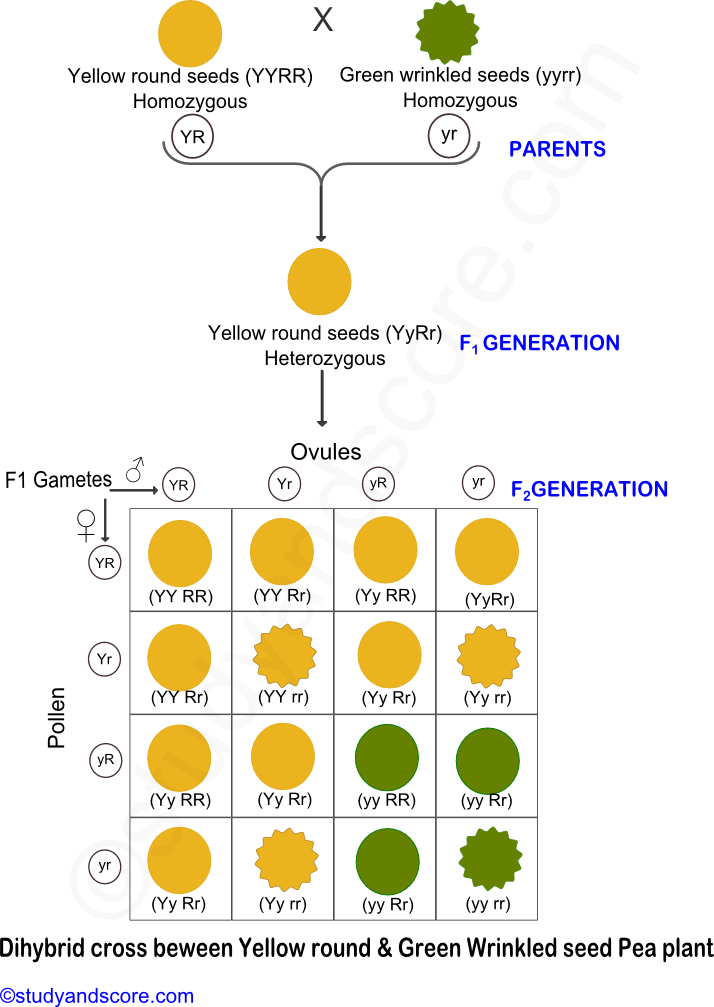Monohybrid cross: A genetic cross between parents that differ in single pair of contrasting characters, controlled by one particular gene is called as Monohybrid cross. One parent is having two dominant alleles and the other parent is having twp recessive alleles. All the F1 generation progeny have one dominant and one recessive allele for that gene i.e. they are hybrid at that one locus. Crossing between the F1 generation progeny yields a characteristic 3:1 ratio in F2 generation. The genotypic ratio in monohybrid cross is
Dihybrid cross: A genetic cross between parents that differ in two pairs of contrasting characters, controlled by genes at different loci is called as dihybrid cross. Mendel executed a dihybrid cross using the characteristics like seed color and texture of pea plant. The parental plants had either smooth yellow seeds (SSYY)-dominant characters or wrinkled green seeds (ssyy)-recessive characters. All the offsprings had smooth yellow seeds being heterozygous (SsYy) for the two alleles. Crossing between these F1 offsprings produced an F2 generation of plants with smooth yellow, smooth green, wrinkled yellow and wrinkled green seeds in the ration 9:3:3:1. These results formed the basis of Law of Independent Assortment.
Monohybrid and dihybrid crosses proved three principles of genetics,
Each of these crosses yielded approximately 3:1 ratio in the second filial generation. The three basic principles of inheritance were established by Mendel monohybrid crosses.
To formulate the Law of Dominance and the Law of Segregation Mendel considered monohybrid crosses in which single pairs of contrasting characters are considered at a time. But to formulate the Law of Independent assortment, he considered dihybrid cross in which two pairs of contracting characters are taken at a time. In this law of independent assortment Mendel tried to find out how different characters would behave in relation to each other in their inheritance from generation to generation.
In his dihybrid experiment, Mendel crossed a homozygous yellow round seeded pea plant with homozygous green wrinkled seeded pea plant. In other words in this experiment he considered two characters at a time that is color and the texture of the seed. The F1 hybrids of this cross have yellow round seeds. When these F1 hybrids were allowed to mate among themselves, they produced four types of seeds in the ratio 9:3:3:1,
Thus Mendel got 3: 1 ration in Monohybrid crosses and 9:3:3:1 ration in dihybrid crosses. This irregularity in the F2 generation was explained by Mendel as “When the parents differ from each other in two or more pairs of contrasting characters, then the inheritance of one pair of factors is independent to that of the other pair of factors”.
For the purpose of better understanding, let us consider the homozygous pea plant with Yellow round seeds has the alleles YY and RR for Yellow color and Roundness of the seeds respectively. Similarly homozygous pea plant with green wrinkled seeds has the alleles tt and rr for green color and wrinkledness of seeds respectively.
The gametes produced by YYRR are ‘YR’ and by yyrr are ‘yr’. The union of these gametes gives rise to a F1 hybrid with YyRr (Yellow round seed). This shows the dominance of allele Y for yellow color and the allele R for the roundness of the seed over their recessive counterparts y and r.
Now the F1 hybrids have four types of alleles

During the gametogenesis for F2 generation these alleles ma combine in following combinations,
Thus four alleles are associates independently to give four types of gametes (YR, Yr, yR, yr). These gametes of F1 generation unite at random, in the process of fertilization and produce sixteen types of individuals in F2 generation in the ration 9:3:3:1.
These results have proved the Law of independent assortment and showed that each pair of contrasting characters behave independently and show no permanent relation with a particular character. The allele Y was associated with R in the parents but it does not always remain so in the subsequent generations. The genotypic ratio in this type of cross is 1:2:2:1:4:1:2:2:1 and the phenotypic ratio is 9:3:3:1.
Hope you have liked this post.
Please share it with your friends through below links.
All the very best from Team Studyandscore
“Study well, Score more…”
- Share with your friends! -
Login to post your comment here...
- or with social Account -